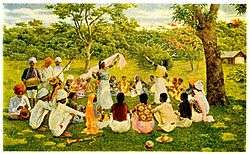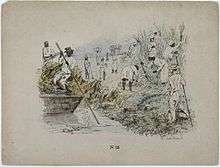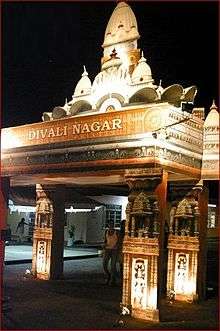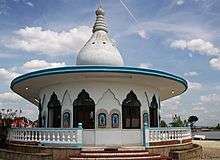Indo-Caribbeans
Indo-Caribbeans or Indian-Caribbeans, are people of Indian descent who live in the Caribbean. They are mostly descendants of the original jahaji Indian indentured workers brought by the British, the Dutch, and the French during colonial times.
| Regions with significant populations | |
|---|---|
| 468,524 (a plurality of the population)[1] | |
| 317,000 (a plurality of the population) | |
| 232,817 (Indo-Caribbean Americans)[2] | |
| 161,000 (a plurality of the population) | |
| 146,000 | |
| 37,530[3] | |
| 36,011[4] | |
| 12,000 | |
| 7,600 | |
| 5,900 | |
| 5,200 | |
| 4,100 | |
| 4,000 | |
| 3,900 | |
| 1,500 | |
| 1,100 | |
| Languages | |
Colonial Languages:
| |
| Religion | |
Predominantly: Minority:
| |
| Related ethnic groups | |
Most Indo-Caribbean people live in the English-speaking Caribbean nations, Suriname, and the French overseas departments of Guadeloupe, Martinique, and French Guiana, with smaller numbers in other Caribbean countries and, following further migration, in Europe and North America.
Sub-groups
Caribbean Islands
- Indians in Barbados
- Indians in the Dominican Republic
- Indo-Grenadians
- Indo-Guadeloupeans
- Indo-Haitians
- Indo-Jamaicans
- Indo-Martiniquais
- Indians in Saint Kitts and Nevis
- Indo-Saint Lucian
- Indo-Trinidadian and Tobagonian
- Indians in the United States Virgin Islands
- Indo-Vincentian
Mainland Caribbean
- Asian Indians in Belize
- Indo-Guyanese
- Indo-Surinamese
- Indians in French Guiana
Primary Diaspora
- Indo-Caribbean Americans
- Indo-Caribbean Canadians
- British Indo-Caribbean people
- Indians in the Netherlands
Secondary/Migrant Workers Diaspora
- Indians in Argentina
- Indians in Venezuela
- Indians in Panama
- Indian immigration to Brazil
- Indians in Colombia
Mixed Ethnicities
Migration history

From 1838 to 1917, over half a million Indians from the former British Raj or British India and Colonial India, were taken to thirteen mainland and island nations in the Caribbean as indentured workers to address the demand for sugar cane plantation labour following the abolition of slavery.
Sugarcane plantations in the 19th century

Much like cotton, sugarcane plantations motivated large-scale near-enslavement and forced migrations in the 19th and early 20th century.[5]
Following the emancipation of slaves in 1833 in the United Kingdom, many liberated Africans left their former masters. This created an economic chaos for British owners of sugar-cane plantations in the Caribbean region, and elsewhere. The hard work in hot, humid farms required a regular, docile and low-waged labour force. The British looked for cheap labour. Since slavery had been abolished, the British crafted a new legal system of forced labour, which in many ways resembled enslavement.[6] Instead of calling them slaves, they were called indentured labourers. Under this indentured labour scheme, Indians (primarily) began to replace enslaved Africans on sugarcane plantations across the British empire.
The first ships carrying indentured labourers for sugarcane plantations left India in 1838 for the Caribbean region. In fact, the first two shiploads of Indians arrived in British Guiana (now Guyana) on May 5, 1838, on board the Whitby and Hesperus. These ships had sailed from Calcutta. In the early decades of the sugarcane-driven migrations, indentured Indians were treated as inhumanely as the enslaved Africans had been. They were confined to their estates and paid a pitiful salary. Any breach of contract brought automatic criminal penalties and imprisonment. Many of these were brought away from their homelands deceptively. Many from inland regions over a thousand kilometers from seaports were promised jobs, were not told the work they were being hired for, or that they would leave their homeland and communities. They were hustled aboard the waiting ships, unprepared for the long and arduous four-month sea journey. Charles Anderson, a special magistrate investigating these sugarcane plantations, wrote to the British Colonial Secretary declaring that with few exceptions, the indentured labourers are treated with great and unjust severity; plantation owners enforced work in sugarcane farms so harshly, that the decaying remains of immigrants were frequently discovered in sugarcane fields. If labourers protested and refused to work, they were not paid or fed: they simply starved.[5]
The sugarcane plantation-driven migrations led to ethnically significant presence of Indians in Caribbean.[7] In some islands and countries, these Indo-Caribbean migrants now constitute a significant proportion of the population. Sugarcane plantations and citizens of Indian origin continue to thrive in countries such as Guyana, formerly, British Guiana, Jamaica, Trinidad and Tobago, Martinique, French Guiana, Guadeloupe, Grenada, St. Lucia, St. Vincent, St. Kitts, St. Croix, Suriname and Nevis.[5][8] By some estimates, over 2.5 million people in the Caribbean are of Indian origin. Many have ethnically blended with migrants from other parts of the world, creating a unique syncretic culture.
Though production was centered in the Caribbean, sugarcane production played a significant role in pre-World War II global politics and population movements. France, for example, negotiated with Britain leading to Act XLVI of 1860, whereby large numbers of Indian indentured labourers were brought for harsh sugarcane plantation work in French colonies in the Caribbean region.[9] The Caribbean colonies of the Netherlands too benefitted from the indentured laborers from India.
Post World War II trends

The majority of the Indians living in the English-speaking Caribbean came from eastern Uttar Pradesh and western Bihar which are mostly Hindi-speakers, while those brought to Guadeloupe and Martinique were largely from Andhra Pradesh and Tamil Nadu. About twenty percent (20%) of the indentured were Tamils and Telugus particularly in Trinidad and Tobago, and Guyana.
A minority emigrated from other parts of South Asia, including present-day Pakistan and Bangladesh.
Indo-Caribbeans comprise the largest ethnic group in Guyana, Trinidad and Tobago, and Suriname.
They are the second largest group in Suriname, Jamaica, Grenada, Saint Vincent and the Grenadines, Saint Lucia, Martinique and Guadeloupe.
There are also small communities in Anguilla, Antigua and Barbuda, The Bahamas, Barbados, Belize, French Guiana, Panama, Dominican Republic, Puerto Rico and the Netherlands Antilles. Small groups also exist in Haiti, where they are sometimes mistakenly referred to as "mulattos".
Contemporary migration
Modern-day immigrants from India (mostly Sindhi merchants) are to be found on Saint-Martin / Sint Maarten, St. Thomas, Curaçao and other islands with duty-free commercial capabilities, where they are active in business. Other Indo-Caribbean people descend from later migrants, including Indian doctors, Gujarati businessmen and migrants from Kenya and Uganda.
Diaspora
Indo-Caribbeans have migrated to the United States, Canada, the Netherlands, France, the United Kingdom, Ireland, and to other parts of the Caribbean and Latin America
Culture

The indentured Indians and their descendants have actively contributed to the evolution of their adopted lands in spite of many difficulties.
Commemoration
In recent years, attempts to commemorate the Indian presence and contributions have come to fruition:
Indian Arrival Day is a holiday celebrated on May 30 in Trinidad and Tobago each year since the 1990s. It was first celebrated in Trinidad and Tobago and then other countries with significant Indian people whose ancestors came as indentured laborers. It commemorates the first arrivals from Akhand Bharat (South Asia) to Trinidad and Tobago, on May 30, 1845, on the ship Fatel Razack
In 1995, Jamaica started to celebrate the arrival of Indians in Old Harbour Bay, St. Catherine Parish on May 13.
In 2003, Martinique celebrated the 150th anniversary of Indian arrival. Guadeloupe did the same in 2004. These celebrations were not the fact of just the Indian minority, but the official recognition by the French and local authorities of their integration and their wide-scale contributions in various fields including agriculture, education, and politics, and to the diversification of the culture of the Creole peoples. Thus, the noted participation of the whole multi-ethnic population of the two islands were in these events.
St. Lucia and many Caribbean countries have dedicated commemorative days to acknowledge the arrival and important contributions of their Indo-Caribbean populations. St. Lucia celebrates its Indo-Caribbean heritage on May 6. Other dates when India Arrival Day is celebrated in the Caribbean include May 5 (Guyana), May 10 (Jamaica), May 30 (Trinidad and Tobago), June 1 (St. Vincent), and June 5 (Suriname).[8]
Indo-Caribbean media - Canada
There are three Indo-Caribbean newspapers based in Toronto:
- Indo-Caribbean World - has been in existence for 25 years
- Caribbean Xpress - has been in existence for five years
- Indo-Caribbean Times - existed for about two years; ceased publication after the death of one its founding members in April 2010
Notable Canadian Indo-Caribbeans
- Anjulie - singer/songwriter; her parents migrated from Guyana
- Dave Baksh - lead guitarist of the band Sum 41; a founding member of the mainly reggae band Brown Brigade; his parents migrated from Guyana
- Bas Balkissoon - born in Trinidad and Tobago, a member of the Provincial Parliament of the Province of Ontario
- Neil Bissoondath - writer, born in Trinidad and Tobago
- Hedy Fry - long-standing Canadian federal politician and physician, born in San Fernando, Trinidad and Tobago; fifth person to ever unseat a sitting prime minister (1993)
- Kamala-Jean Gopie - educator and political activist; (Jamaican born)
- Ian Hanomansing - born in Trinidad and Tobago, a television anchor and reporter with the Canadian Broadcasting Corporation (CBC)
- Shani Mootoo - writer, born in Ireland to Trinidadian parents
- Lakshmi Persaud - writer on Indo-Caribbean themes, Trinidad born
Other notable Indo-Caribbeans
Politics and Government
- Basdeo Panday
- Kamla Persad-Bissessar
- Noor Mohamed Hassanali
- Rudranath Capildeo
- Simbhoonath Capildeo
- Capildeo family
- Bhadase Sagan Maraj
- Satnarayan Maharaj
- Adrian Cola Rienzi
- Ramesh Maharaj
- Linda Baboolal
- Raziah Ahmed
- Roodal Moonilal
- Ralph Maraj
- Raffique Shah
- Cindy Devika
- Sharma Mohammed
- Faisal Rahman
- Surujrattan Rambachan
- Fuad Khan
- Winston Dookeran
- Kieron Joseph Samaroo
- Ashford Sastri Sinanan
- Anand Ramlogan
- Devant Maharaj
- Peter Jamadar
- Heeralal Rampartap
- Jean Ramjohn-Richards
- Waheed Alli, Baron Alli – life peer in the British House of Lords
- Shaik Baksh, Minister of Education
- Cheddi Jagan – former President of Guyana
- Bharrat Jagdeo – former President of Guyana
- Moses Nagamootoo – Prime Minister of Guyana
- Reepu Daman Persaud
- Shridath Ramphal – former Commonwealth Secretary General
- Donald Ramotar – former President of Guyana
- Peter Ramsaroop
- Tara Singh Varma – Dutch politician
- Syed Kamall - British MEP for London since 2005
- Kayman Sankar - politician and rice farmer
- Gina Miller - British lawyer who took the UK Government to court over its handling of Brexit negotiations.
- Balram Singh Rai - politician
- Ranji Chandisingh - politician
- Lionel Luckhoo - politician and lawyer
- Edward Luckhoo - politician and Governor-General of British Guiana and Acting President of Guyana
- Ashwin Adhin, Surinamese Vice President
- Chan Santokhi - ex-chief of police, Progressive Reform Party politician
- Fred Ramdat Misier - politician
- Jagernath Lachmon - politician, ex-Speaker of the National Assembly of Suriname
- Pretaap Radhakishun - former Prime Minister of Suriname
- Ram Sardjoe - politician, ex-Speaker of the National Assembly of Suriname
- Ramsewak Shankar - politician
- Robert Ameerali - politician
- Tanja Jadnanansing - Labour Party politician
Literature
Sports
- Samuel Badree
- Denesh Ramdin
- Ravi Rampaul
- Manny Ramjohn
- Sunil Narine
- Daren Ganga
- Hermat Gangapersad
- Robin Singh
- Adrian Barath
- Inshan Ali
- Rayad Emrit
- Rangy Nanan
- Sonny Ramadhin
- Rajindra Dhanraj
- Amit Jaggernauth
- Ishwar Maraj
- Suruj Ragoonath
- Dinanath Ramnarine
- Charran Singh
- Subhash Gupte
- Greg Ranjitsingh
- Anisa Mohammed
- Nicholas Pooran
- Kendall Jagdeosingh
- Ria Ramnarine
- Shivnarine Chanderpaul – former captain of the West Indies cricket team
- Narsingh Deonarine – West Indian cricketer
- Rohan Kanhai – former captain of the West Indies cricket team
- Alvin Kallicharran – former captain of the West Indies cricket team
- Kriskal Persaud – chess player
- Harry Prowell – Marathon Olympian and British West Indies Champion in long-distance running
- Mark Ramprakash – British cricketer
- Dinesh Ramdin - Former Wicket-keeper
- Ravi Rampaul - Fast Bowler
- Ramnaresh Sarwan – former captain of the West Indies cricket team
- Dhanraj Singh – boxer
- Sunil Narine - Spinner
- Devendra Bishoo – a prominent leg spinner of the West Indies cricket team
- Beni Sankar – businessman and former cricket player
- Rajiv Maragh - jockey
- Shaun Bridgmohan - jockey
Arts and Entertainment
- Sundar Popo
- Ravi Bissambhar
- Rikki Jai
- Rakesh Yankaran
- Parvati Khan
- Heeralal Rampartap
- Adesh Samaroo
- Drupatee Ramgoonai
- Jit Samaroo
- Neeshan Prabhoo
- Ria Carlo
- Lakshmi Singh
- Gerry Bednob
- Errol Sitahal
- Chris Bisson
- Valene Maharaj
- Ian Hanomansing
- Ira Mathur
- Wendy Rahamut
- Natasha Ramsahai
- Lennox Mohammed
- Surujpat Mathura
- Kimberly Farrah Singh
- Chandini Chanka
- Ysabel Bisnath
- Anjulie – Canadian singer-songwriter
- Dave Baksh – lead guitarist of the Canadian band Sum 41 (also plays with Brown Brigade)
- Shakira Caine – actress, fashion model, and former Miss Guyana
- Rhona Fox – actress
- Terry Gajraj – chutney singer
- Harischandra Khemraj – writer
- Laxmi Kallicharan – writer
- Raymond Ablack – Canadian actor
- Gordon Warnecke – British actor
- Melinda Shankar – Canadian Actress
- Sandhja – Finnish singer
- Prem Radhakishun
- Fareisa Joemmanbaks, model and actress
Science, Medicine, and Health
- Rajendra Persaud
- Lall Sawh
- Jean Ramjohn-Richards
- Ria Persad
- Sandra Ramdhanie
- Anna Mahase
- Stella Abidh
Religion, Philanthropy, and Philosophy
Pundits
- Dharmachariya Pandit Ramlall
- Dharmachariya Shri Mahant Deodath Dass
- Dharmacharya Pandit Arjun Doobey[11]
- Pundit Rudranath Maharaj
- Pundit Bal Gangadhar
- Acharya Pundit Prakash Gossai
- Pundit Krishna Harrybatchan
- Pundit Deonarine Gajraj Maharaj-Agnihotri[12]
- Pundit Hardath Maharaj
- Dharmacharya Pundit Krishna Maharaj
- Pundit Mahase Maharaj
- Pundit Mahadeo Maharaj
- Pundit Munelal Maharaj
- Pundit Nirmal Maharaj
- Pundit Parasram Maharaj
- Dharmacharya Pundit Uttam Maharaj
- Pundit Capildeo Maharajh
- Dharmacharya Pundit Basdeo Misir
- Pundit Sriram Jadoonanan Misra
- Pundit Kashiprasad Mishra
- Dharmacharya Pundit Rampersad Parasram
- Pundit Samsundar Parasram
- Doon Pundit
- Dharmacharya Pundit Krishna Rambally
- Pundit Seusankar Seunarine
- Pundit Abhedanand Persad Sharma
- Pundit Harripersad Sharma
- Dharmacharya Pundit Jankie Persad Sharma
- Dharmacharya Pundit Sahadeo Persad Dubay Sharma
- Dharamacharaya Mahant Garib Sieuraj
- Pundit Rampersad Tewarie (Darhi Baba)
- Pundit Sahadeo Tiwari
- Pundit Teeluckdharry
- Pundit Ramdath Vyas
Criminals
- Dole Chadee (born Nankissoon Boodram)
- Boysie Singh
See also
- Hinduism in the West Indies
- Indian people
- Indian diaspora
- Bhojpuri people
- Awadhi people
- Tamil diaspora
- Indo-Caribbean music
- British Indo-Caribbean people
- Indo-Caribbean Americans
- Indo-Caribbeans in the Netherlands
- Anglophone Caribbean
- Coolitude
- Bombay (mango)
- Dhantal
- Tassa
- Indian Caribbean Museum of Trinidad and Tobago
References
- "TRINIDAD AND TOBAGO 2011 POPULATION AND HOUSING CENSUS DEMOGRAPHIC REPORT" (PDF). Guardian.co.tt. Archived from the original (PDF) on 19 October 2017. Retrieved 2 August 2017.
- "Indo-Caribbean Times December 2007 - Kidnapping - Venezuela". Scribd. Retrieved 17 August 2018.
- "Martinique Population 2020". World Population Review. World Population Review. Retrieved 16 May 2020.
- "Guadeloupe Population 2020". World Population Review. World Population Review. Retrieved 16 May 2020.
- "Forced Labour". The National Archives, Government of the United Kingdom. 2010.
- Hugh Tinker (1993). "New System of Slavery". Hansib Publishing, London. ISBN 978-1-870518-18-5. Missing or empty
|url=(help) - K Laurence (1994). "A Question of Labour: Indentured Immigration Into Trinidad & British Guiana, 1875-1917". St Martin's Press. ISBN 978-0-312-12172-3. Missing or empty
|url=(help) - "St. Lucia's Indian Arrival Day". Caribbean Repeating Islands. 2009.
- "Indian indentured labourers". The National Archives, Government of the United Kingdom. 2010.
- http://www.hindisongstt.com/artist_listing.php?catId=17
- https://www.hinduismtoday.com/modules/smartsection/item.php?itemid=3520
- http://ftp.guardian.co.tt/lifestyle/2011/10/26/late-pandit-unsung-hero-hinduism
External links
| Wikimedia Commons has media related to Indian diaspora in the Caribbean. |
- Indo-Caribbean Alliance, Inc. - a 501(c)3 non-profit organization providing services and advocacy to New York City's growing Indo-Caribbean community
- Jahajee Sisters: Empowering Indo-Caribbean Women - a movement-building organization, led by Indo-Caribbean women, committed to fighting gender-based violence and advocating for reproductive justice. Jahajee Sisters fosters solidarity and empowerment through dialogue, arts, leadership development and grassroots organizing.
- South Asian Indentured Labor - Online Archive of Research and Resources - an online archive and living syllabus of text-based resources related to Indian indentureship, with country-specific resources related to Indians indentured to the Caribbean and the Indo-Caribbean diaspora
- Gupta, Bashabi (2011). "Indian Diaspora in the United States: Brain Drain or Gain?". Diaspora Studies. 5 (1): 139–154. ISSN 0973-9572.
